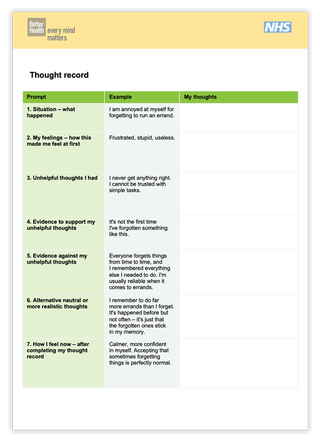Thought record
A thought record is a common cognitive behavioural therapy (CBT) exercise.
It's a practical way to capture and examine your thoughts and feelings about a situation, and your evidence for them, using a set of 7 prompts.
Doing this can help you understand how linked our thoughts and behaviours can be, and how they influence each other.
Completing this process is a good way to recognise when thoughts and behaviours are unhelpful, and begin to challenge and reframe them in different ways.
How to complete a thought record
Before you start, make sure you have a situation in mind that you want to work through. You can use this for any difficult situation or problem you have had recently.
You can complete the exercise just by thinking through the 7 steps below in your head if you like, but it's usually best if you have some way of writing things down. This means you can keep hold of it and refer back to it later if you want to.
You can do this with a pen and paper, an app on your phone, by downloading and filling in the linked document electronically, or by printing the document and filling it in.
When you're ready, start working through the steps in order. Take your time and try to be as honest as you can.

My thought record
1. The situation – what happened?
For example: "I am annoyed at myself for forgetting to run an errand."
2. My feelings – how this made you feel at first
For example: "Frustrated, stupid."
3. Unhelpful thoughts I had
For example: "I never get anything right. I'm useless and cannot be trusted with simple tasks."
4. Evidence to support my unhelpful thoughts
For example: "It's not the first time I've forgotten something like this."
5. Evidence against my unhelpful thoughts
For example: "I remembered everything else I needed to do. I'm usually very reliable when it comes to errands and don't put anything off."
6. Alternative, more realistic or neutral thoughts
For example: "I remember to do far more errands than I forget. It's happened before but not often – it's just that the forgotten ones stick in my memory. Most of the time I am a trustworthy and reliable person."
7. How I feel now – how your feelings have changed after completing your thought record
For example: "Calmer, more confident in myself – I am neither stupid nor useless. Accepting that everyone forgets things from time to time."

Self-help CBT techniques
Find out what CBT is, watch video guides, and try a range of online techniques to help you deal with worries, work through problems in a new way, build resilience and boost your mental wellbeing.